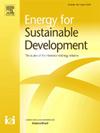Projection of Electricity Generation Profiles and Carbon Emissions Towards 2050: A Malaysia Context
IF 4.4
2区 工程技术
Q2 ENERGY & FUELS
引用次数: 0
Abstract
The planning of future energy systems that incorporate a significant share of renewable energy (RE) is gaining importance as a solution to energy security and environmental issues. In bottom-up energy system modelling, there are two primary approaches: one focuses on optimising the energy mix for a specific target year (static), while the other seeks to optimise the transition from the current reference to a target year (long-term). This paper aims to model and analyse Malaysia's renewable energy transition towards 2050 with both static and long-term approaches. The Low Emissions Analysis Platform (LEAP) was used to develop five Malaysian national energy system models from 2020 to 2050 with primary focus on the power sector. Optimal energy storage capacities were investigated in the National Energy Transition Roadmap (NETR 2050) model using the coupling of LEAP with Next Energy Modelling system for Optimization (NEMO). For the Reference Model (2020), the total electricity generation was at 153.8 TWh/year mainly driven by coal and natural gas. With LEAP-NEMO optimisation in the NETR 2050 model with the integration of battery energy storage systems (BESS) and pumped hydro storage (PHS), the total annual electricity generation was 270.6 TWh/year with contributions from natural gas and solar. For the total emissions in all sectors, the results for models 1 to 5 resulted in 287.5, 321.5, 382.1, 404.5, and 466.3 Mt. CO2 respectively. With LEAP-NEMO optimisation and energy efficiency for demand reduction, model 5 was improved to be at 449.7 Mt. CO2 mainly due to the smaller electricity generated by natural gas in the power sector. Based on the economic results of the two long-term scenarios, the total net present value was calculated to be 1210.7 billion USD for NETR 2050 with respect to Ref (2020). With the LEAP-NEMO optimisation, the total net present value resulted in 1005.7 billion USD. Based on the LEAP results, a significant shift in the technological landscape will be required, with RE, energy storage systems (ESS), and energy efficiency taking on key roles. The findings from this paper can aid researchers and policymakers in creating strategic plans in RE and ESS development that can be applied to the case of Malaysia and other countries.
到2050年的发电概况和碳排放预测:以马来西亚为例
作为能源安全和环境问题的解决方案,未来能源系统的规划纳入可再生能源(RE)的重要份额正变得越来越重要。在自下而上的能源系统建模中,有两种主要方法:一种侧重于优化特定目标年(静态)的能源结构,而另一种则寻求优化从当前参考到目标年(长期)的过渡。本文旨在用静态和长期方法建模和分析马来西亚到2050年的可再生能源转型。低排放分析平台(LEAP)用于开发2020年至2050年的五个马来西亚国家能源系统模型,主要关注电力部门。在国家能源转型路线图(NETR 2050)模型中,利用LEAP与下一代能源建模优化系统(NEMO)的耦合,研究了最优储能容量。参考模型(2020年)总发电量为153.8太瓦时/年,主要由煤和天然气驱动。结合电池储能系统(BESS)和抽水蓄能(PHS), NETR 2050模型中的LEAP-NEMO优化后,年总发电量为270.6太瓦时/年,其中天然气和太阳能的贡献。对于所有部门的总排放量,模型1至模型5的结果分别为287.5、321.5、382.1、404.5和466.3 Mt. CO2。通过LEAP-NEMO优化和能源效率降低需求,模型5被改进为4.497亿吨二氧化碳,这主要是由于电力部门使用天然气产生的电力较少。根据两种长期情景的经济结果,计算出NETR 2050相对于Ref(2020)的总净现值为12107亿美元。通过LEAP-NEMO优化,总净现值为10057亿美元。根据LEAP的结果,技术格局将需要发生重大转变,可再生能源、储能系统(ESS)和能源效率将发挥关键作用。本文的发现可以帮助研究人员和决策者制定可再生能源和可再生能源发展的战略计划,这些计划可以应用于马来西亚和其他国家的案例。
本文章由计算机程序翻译,如有差异,请以英文原文为准。
求助全文
约1分钟内获得全文
求助全文
来源期刊

Energy for Sustainable Development
ENERGY & FUELS-ENERGY & FUELS
CiteScore
8.10
自引率
9.10%
发文量
187
审稿时长
6-12 weeks
期刊介绍:
Published on behalf of the International Energy Initiative, Energy for Sustainable Development is the journal for decision makers, managers, consultants, policy makers, planners and researchers in both government and non-government organizations. It publishes original research and reviews about energy in developing countries, sustainable development, energy resources, technologies, policies and interactions.
 求助内容:
求助内容: 应助结果提醒方式:
应助结果提醒方式:


